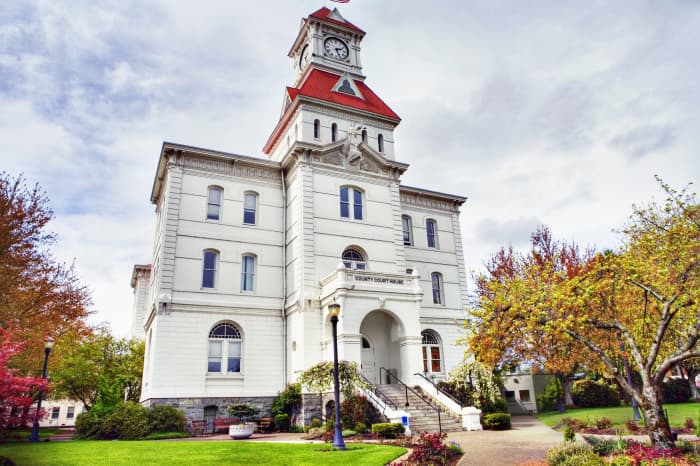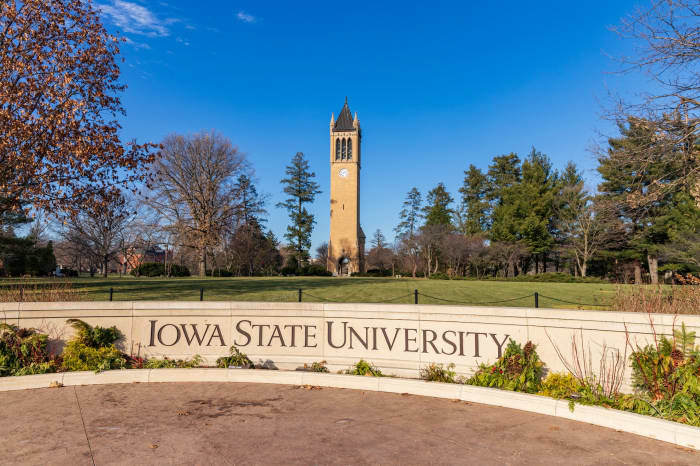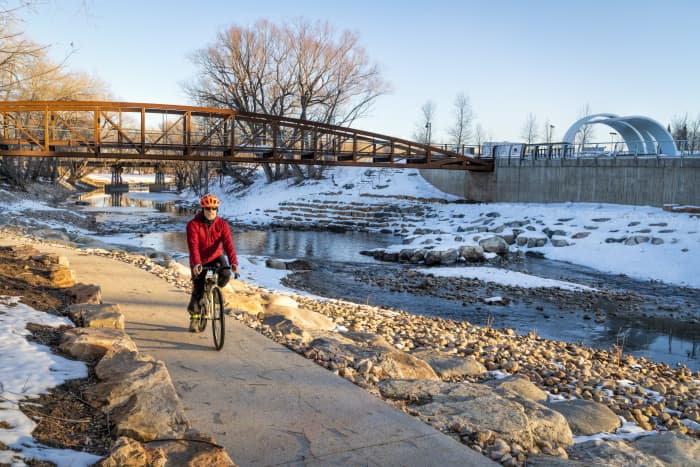MarkerWatch – Best New Ideas in Money
June 1, 2023
To change the world, we may need to change money first. Best New Ideas in Money explores innovations that rethink how we live, work, spend, save and invest. Each week, MarketWatch reporter Charles Passy and economist Stephanie Kelton will talk to leaders in business, tech, finance and government about the next phase of money’s evolution, and meet real people whose lives are being changed as these new ideas are put to the test.
More Ways to Listen
That’s the premise of Tulsa Remote, and the program is far from alone: Cities across the country are competing for workers who can work from anywhere.
Full Transcript
This transcript was prepared by a transcription service. This version may not be in its final form and may be updated.
Raj Choudhury: Given the prevalence of work from anywhere as a work arrangement now it gives policy makers an opportunity to try to leverage this and attract their communities, their region’s workers who can work remotely.
Stephanie Kelton: Welcome to the Best New Ideas in Money, the podcast for Market Watch. I’m Stephanie Kelton. I’m an economist and a professor of economics and public policy at Stony Brook University.
Charles Passy: And I’m Charles Passy, a reporter at Market Watch.
Stephanie Kelton: Each week we explore innovations and economics, finance, technology, and policy that rethink the way we live, work, spend, save, and invest. So Charles, before we get started, I think you have some news that you want to share with our listeners.
Charles Passy: I sure do, Stephanie. So this will be my next to last episode of Best New Ideas in Money. I’ve really loved working on the podcast, but time has come to step aside and let somebody else from the Market Watch team take over. I’ll be doing a little bit more writing for Market Watch, which is my primary duty at the publication.
Stephanie Kelton: Well, I’ve had an absolute blast working with you, Charles. We will miss you and I’m going to continue to read everything you write at Market Watch.
Charles Passy: That’s great. I appreciate that. I’m happy to say that my colleague James Rogers will be taking my place. James is a financial columnist at Market Watch and he has been covering money and technology for decades.
Stephanie Kelton: So you’re saying we’re in good hands?
Charles Passy: Very much. And next week James and I will co-host an episode about why many innovative projects fail and what these failures can teach us about taking meaningful risks. So as always, stay tuned.
Stephanie Kelton: Charles, if you are going to work from anywhere, where would that be?
Charles Passy: I’m going to say a place called Block Island. It’s a island community in Rhode Island. Very remote, very peaceful. I think it’s the kind of place where you could really hunker down and do some really quality work in peace. What about you, Stephanie?
Stephanie Kelton: That sounds pretty nice. Well, I mean, I live on the north shore of Long Island, so it’s pretty peaceful. I’ve got a lot of space. We have the water, but I guess maybe I would go somewhere where there are mountains, maybe a lot of nature, low humidity, nice hiking trails, maybe Colorado.
Charles Passy: So as you might have guessed, working from anywhere is the subject of today’s episode. A few weeks back we talked about the impact of remote and hybrid work on commercial real estate cities and even the economy. Put simply what happens if people stop going to the office.
Stephanie Kelton: Today we’re taking a look at another piece of this puzzle, which is, does remote work present an opportunity for cities and regions across the United States to compete for workers who can, well, work from anywhere?
Charles Passy: But first, when we say remote work, what exactly do we mean?
Johnny C. Taylor Jr.: First of all, it’s really important that we distinguish remote work, which I will say is fully remote from hybrid, from in the office.
Stephanie Kelton: That’s Johnny C. Taylor Jr. President and CEO of the Society for Human Resource Management or SHRM.
Johnny C. Taylor Jr.: Remote work is where your full-time job is working away from an office. Hybrid, which has really become all the rage is where you spend some portion of time in your employer’s physical office space and another portion of time at wherever you’d like to work remotely. And then the obvious is the traditional in-office work environment.
Charles Passy: We’re focusing specifically on fully remote work. So how many jobs does Taylor Jr estimate will be fully remote in the near future?
Johnny C. Taylor Jr.: We believe the number is going to settle in somewhere between 12 and 15% where people will be able to work remotely full time. We believe that’s where we’re going to settle. Obviously none of us know, but that’s our best guess.
Stephanie Kelton: Estimates vary and they’re contested and debated on the higher end the freelance platform, Upwork anticipates that as much as 22% of the United States workforce could become remote by 2025.
Charles Passy: But we’re not there yet. And a more conservative estimate is roughly in line with Taylor Jr’s as of its most recent count. In February, 2023, Stanford University’s monthly study on remote work found that 12% of workers were fully remote.
Stephanie Kelton: But if we stick with Taylor Jr’s range 12 to 15%. That’s between 20 and 25 million workers in the United States.
Charles Passy: That’s a lot of fully remote workers.
Stephanie Kelton: It really is Charles, and it also means that 20 to 25 million workers are potentially up for grabs. To understand more about the race for talent this pool of jobs may create we spoke to three academics who co-authored a study for the Brookings Institution about work from anywhere as policy. They looked at a program called Tulsa Remote, which we’ll hear about later in the episode.
Charles Passy: Before we do, what’s the new idea here? What does work from anywhere say about how the geography of work may be shifting?
Evan Starr: For most of history where workers live has been tied to the jobs that they have.
Charles Passy: That’s Evan Starr, a professor of economics at the University of Maryland, and one of the co-authors of the Brookings Report on work from anywhere as policy.
Evan Starr: So if a locality wants to bring in a bunch of workers and jobs, historically, the main way to do that has been to try to bring in companies.
Stephanie Kelton: Why do companies benefit cities and states? Well, two of the big reasons are they broaden the tax base and they bring jobs.
Charles Passy: And if you remember anything that happened before the COVID-19 pandemic, you might remember the big brouhaha over where Amazon was going to build its HQ two,
Speaker 6: Amazon’s shopping for a second headquarters bringing up to 50,000 jobs to the city the online retail giant selects.
Speaker 7: Amazon will feel right at home here.
Speaker 8: Of the nearly 240 bids from across America. The 20 finalists are mostly in the east and south from big cities like Boston, Dallas, and Atlanta to the mid-size like Columbus, Raleigh, and Nashville.
Stephanie Kelton: Cities and states across America compete with each other to lure corporations typically by offering them valuable tax credits and subsidies or granting them other favorable treatment. And Amazon’s HQ2 was the ultimate big fish pitting cities against cities and states against states.
Charles Passy: Ultimately, Amazon settled on a new build in northern Virginia outside of Washington DC and after a whole lot of controversy leased additional space in New York City where it had originally intended to build a large complex. And notably this year after cutting thousands of jobs, Amazon recently paused construction of its Northern Virginia headquarters.
Stephanie Kelton: The point is with work from anywhere, how cities compete for jobs could be changing. Back to Starr.
Evan Starr: In this day and age where we have these remote workers who can work from anywhere who aren’t tied to location, we can now separate the company from where they live. And so we can have these municipalities competing for the location of the individual while simultaneously having employers competing over their labor. So we’ve split this classic connection of where you work and where you live. And I think that kind of gave all of these programs, these work from anywhere as policy programs a boost.
Stephanie Kelton: What exactly is work from anywhere as policy? Raj Choudhury is another co-author of the Brookings Report, as well as a professor at Harvard Business School. Choudhury studies the future of work, and in particular how the geography of work is changing.
Raj Choudhury: Given the prevalence of work from anywhere as a work arrangement now, it gives policy makers an opportunity to try to leverage this and attract to their communities, their towns, their regions workers who can work remotely. And this is especially salient for towns and cities and regions that have witnessed a lot of talent flight, brain drain, or have had problems retaining their own young workers. So I think if you can incentivize remote workers to relocate to your town, your city, or your region, then you are leveraging work from anywhere as a policy.
Charles Passy: Why is this important? For Choudhury it presents an opportunity.
Raj Choudhury: So in the case of the US, the smaller towns in the middle of the country lose talent with the larger cities on the coasts. And this has been described as a chicken and egg problem. So if you were a mayor or a policymaker in one of these smaller towns, it’s hard for you to try to convince companies to come and set up factories or offices or warehouses in your town because there’s no talent. The talent is leaving. And it’s also hard to convince your residents to stay back because there are no jobs. And so the argument we’ve made in the past is that remote work and work from anywhere breaks this chicken and egg problem because the remote workers come with their own jobs.
Charles Passy: In Choudhury’s view, it’s a win-win. Remote workers bring their jobs and their higher salaries and spend money and pay taxes, which all benefits communities. And if some of these remote workers go on to start companies or open businesses, well, it’s a new way of doing economic development.
Stephanie Kelton: The incentives for cities and states are fairly clear and as a result, the number of work from anywhere as policy programs is growing. Here’s Thomaz Teodorovicz, a professor in the Department of Strategy and Innovation at the Copenhagen Business School. Teodorovicz is the third and final co-author on the Brookings study.
Thomaz Teodorovicz: Right now. We know of more than 17 municipalities who have some type of relocation incentive programs, and they are distributed in several states, West Virginia, Maine, Vermont, Michigan, Iowa, Oklahoma, Alaska, Hawaii. You can see them spread out across all the country. And if you look internationally in 2022, there are over 40 countries that started issuing digital nomad visas.
Charles Passy: Digital nomad visas are pretty much exactly what you’d expect them to be, a type of visa that authorizes the holder to work remotely in another country. And in 2023, there may be more than 50 countries worldwide, which offers some type of digital nomad visa.
Stephanie Kelton: Although the United States doesn’t offer digital nomad visas, Teodorovicz believes that we’ll be seeing more and more of these work from anywhere incentive programs.
Thomaz Teodorovicz: So we are seeing an increase in interest, and that has not diminished even after the COVID pandemic has started, we are have seen a little. So my expectations, this will continue to increase to a certain extent. And right now we’re just starting to explore what is the potential of Working-From-Anywhere as a policy.
Charles Passy: But wait a minute, if one of the inducements for workers is taking their big city salary and moving to a place with a lower cost of living well, aren’t companies going to eventually start to say, “Hey, I’m not going to pay somebody in Tulsa what I pay somebody in New York City? I’m going to adjust for cost of living?”
Stephanie Kelton: Let’s go back to Johnny C. Taylor Jr. President and CEO of SHRM.
Johnny C. Taylor Jr.: It’s actually being hotly debated right now is if in fact you should make cost of living adjustments for people who choose to work remotely. If one currently works in New York City and is going to move to Idaho, perhaps we should decrease your pay. Because if the opposite were occurring, if we were asking someone who lives in the Midwest to move to New York City, we would increase their pay.
Charles Passy: And thinking about these digital nomad visas, couldn’t jobs done anywhere, literally be done anywhere? Meaning if I’m an employer, why would I pay an employee an American salary to work in a country with a much lower cost of living?
Stephanie Kelton: It’s not quite so simple and there are meaningful business labor and tax implications to consider when employers weigh moving jobs abroad. But the point is for employees, be careful what you wish for. Here’s Taylor Jr.
Johnny C. Taylor Jr.: Well, that’s precisely what happened to me as the CEO of SHRM, I had an employee who came in fully prepared, made a very compelling case for why her job could be done remotely, fully, remotely. She wanted to go live in the Caribbean and she could do her work. She didn’t really interact with her fellow colleagues, wasn’t involved in innovation, et cetera. And so she could do it remotely. And I said, “You raise a really important point, but be careful because what you’ve actually done is convinced me that there is no value in me carrying you as a full-time employee, which includes benefits, annual merit increases, et cetera. I could actually get your work done more cost effectively going outside of the country. So while you’re looking to work remotely, I’m looking for remote employees, including elsewhere on the globe.”
Charles Passy: Would $10,000 convince you to move to Tulsa, Oklahoma for one year? Plus we’ll look at another side of the story or what happens when a so-called Zoom town sees too much remote work too fast?
Stephanie Kelton: Welcome back to the Best New Ideas in Money. Before the break we considered how tens of millions of work from anywhere jobs could create a new way in which cities and states consider economic development.
Charles Passy: But what does this actually look like? Our next guest is Justin Harlan, managing director of Tulsa Remote, the program we mentioned earlier. So what exactly is Tulsa Remote?
Justin Harlan: At its core, Tulsa Remote is a one-year program that offers a $10,000 grant and additional benefits to eligible remote workers who move to and work from Tulsa for a year.
Charles Passy: Wait a minute. So if you move to Tulsa for a year and bring your job with you, you get $10,000. How does this work?
Justin Harlan: It’s a fairly quick and easy process is our hope. You jump online, tulsaremote.com, you submit your application. There’s some basic eligibility requirements like having a full-time remote job, living outside of Oklahoma for at least the last year and being eligible to work in United States. And then if you do get invited to move to Tulsa through Tulsa Remote, you have a year to do so. You can move at any time. And when you’re here, you let us know you sign up for an orientation and that’s when we start really trying to help you get integrated into the city and get you connected to the events and connect you with other people.
Stephanie Kelton: And the program is popular. According to Harlan. Tulsa Remote receives about 10,000 applications a year.
Justin Harlan: We started off pretty small. Our cohort in that first year in 2019 was about 70 people. And then in 2020, obviously everything changed. We had about 350 people move to the city, and then that number grew to about 950 people in 2021. And last year we brought in just under 800. So all in all, we’ve brought in over 2300 people to the city thus far. And one of the things that we’re probably most proud of at Tulsa Remote is the fact that about 90% of people that come to Tulsa through the program are staying beyond that year. We have recently surveyed our alumni and know that about 75% of folks that have ever come through the program and have finished that year are still around in Tulsa today, contributing in meaningful ways and choosing to call it home.
Charles Passy: For context, the population of Tulsa is about 400,000. So who are these Tulsa Remoters?
Justin Harlan: 35 is the average age and $100,000 is the average salary. So we see people that are kind of within their career. They’re not entry level folks on average. And the biggest places we see those folks coming from are those big expensive cities like New York and LA and San Francisco and Austin, and really tapping into Tulsa as a place that has high quality of life at a low cost of living.
Stephanie Kelton: It’s not the same measure as average salary, but the real median household income in Tulsa was about $52,000, according to the Census Bureau.
Charles Passy: Stephanie, I’ve been thinking 2300 remote workers at $10,000 each. That’s $23 million. Not to mention staff like Harlan, where’s this money coming from?
Stephanie Kelton: That’s a great question, Charles. Here’s Harlan.
Justin Harlan: Our program is fully funded by the George Kaiser Family Foundation. It’s a large philanthropic organization here in the city of Tulsa, and we also had some legislation passed recently at the state of Oklahoma that essentially incentivizes programs like ours to bring quality remote jobs to the state by reimbursing us up to $10,000 if somebody sticks around for a couple of years. So it’s kind of paying for success that employer tax dollars that are coming with an individual to the state are then coming back to the program that brought that individual.
Stephanie Kelton: According to a November, 2022 story in Oklahoma’s journal record, Tulsa Remote is expected to hit 5,000 jobs and $500 million in new local earnings by 2025. When we spoke, Harlan said they’re on track to exceed those numbers.
Charles Passy: On the other hand, Tulsa has a significant poverty rate, 18% compared to 11.6% nationally. And despite the low cost of living that Tulsa Remote advertises, Tulsa is itself in the grips of a housing crisis. We asked Harlan if some Tulsa’s have questioned why all of this money isn’t being invested into programs that benefit those who need the help and who already live in Tulsa.
Justin Harlan: I believe that both are necessary. In Tulsa we need to continue to attract talented and diverse people to add to the incredibly talented and diverse folks that are already here, which will grow our city and grow the opportunities that exist in our city, which I believe raises the floor for everybody. And one of the beautiful things about working for a program that’s underneath the Georgia Kaiser Family Foundation is I see the annual budget and I know that Tulsa Remote is a very small sliver of the annual budget and the vast majority of the rest of that money is being spent at a local level. So we believe it’s an important both/and we can do both simultaneously and we can do them both really well.
Stephanie Kelton: In Harlan’s view. It’s really a different model of economic development.
Justin Harlan: The traditional economic development approach has been you try to go after a company and you go all in and you invest incentives and you roll out the red carpet in hopes of them bringing hundreds of jobs with them. Our approach has been quite different by going after the individual instead of creating one basket that we’re putting all of our eggs in the form of a company. In our case at Tulsa Remote, we’ve created 2300 different baskets that all primarily have different employers. I think it really creates a less risky, far more differentiated approach to economic development that’s rooted in an individual as opposed to a company.
Charles Passy: Stephanie, you are the economist. What do you think about this?
Stephanie Kelton: Well, it makes a lot of sense and it makes a lot of sense as someone who thinks about finance too, right? I mean, if you were building a portfolio, you wouldn’t just put stocks from a couple of behemoth companies in there. You’d want to diversify your portfolio so it would be less risky. And that’s what this feels like to me. Now, on the other hand, if too many remote workers suddenly descend on a city that isn’t prepared for them, well, that can create a whole lot of problems.
Brian Guyer: Hi everybody. My name is Brian Guyer. I am the housing director for HRDC, the Human Resources Development Council here in Bozeman, Montana.
Stephanie Kelton: The population of Bozeman, Montana is about 50,000 people, but Bozeman is growing fast.
Brian Guyer: Bozeman, during the pandemic was affectionately dubbed a Zoom town by a lot of national publications because quite frankly, it’s a great place to be a remote worker. There’s a lot to love outdoors, a lot of natural amenities that are really attractive to a lot of people, and it’s also a really vibrant community.
Charles Passy: Bozeman is popular and it has been for a while, but during the height of the COVID-19 pandemic, it got even more popular. And unlike a big city, a city of 50,000 people typically has far less capacity to absorb new arrivals who put a strain on often already burdened resources like housing and infrastructure.
Stephanie Kelton: That’s right. Take housing for example. In March of 2020, the median listing price in Bozeman was about $643,000. In January of 2022, it had shot up to $1.8 million.
Charles Passy: That’s higher than Manhattan.
Stephanie Kelton: No kidding. And although that number has since dropped today, it’s still very high, nearly $1.3 million. Meanwhile, according to the Census Bureau, the median household income in Bozeman was about $67,000 in 2021. How did locals respond to this meteoric rise in the cost of housing? Here’s Guyer.
Brian Guyer: We were just in shock at what was going on, and our focus and the focus of a lot of our discussions was on that cost of a single family home and what are we going to do about home ownership opportunities for our workforce? But at the same time, probably the more difficult problem was the rapidly increasing cost of rental units, and that’s something that has really had a profound impact on our local workforce.
Stephanie Kelton: If you’ve watched the show Yellowstone, the fictional drama between longtime residents and new arrivals bear some resemblance to what’s happening in Bozeman today. What does that look like?
Brian Guyer: One of the things that kind of is in my purview is homeless shelters, and we are seeing more and more of our guests who are working multiple jobs. So our staff are waking folks up at 4:00 AM to get off to their early shift. We’re keeping our doors open late because they’re coming home from the late shift. So in a real perverse sort of way, the shelter is workforce housing.
Charles Passy: But the housing affordability issue doesn’t only impact lower income residents.
Brian Guyer: We are seeing more and more people coming to the table to talk about housing solutions who aren’t traditionally at the table. So these employers are losing this sort of middle management talent to other more affordable communities. And when that starts to happen, employers are finding themselves at the table saying, “I have to have a viable business, and if I can’t have housing for my mental management, then my business is not as viable as it may have once been.”
Charles Passy: Despite these issues, the state of Montana has a major initiative called Come Home Montana. It aims to attract remote workers from anywhere and especially to bring home Montanans who have left the state. Why? Well, in a state that was and still is struggling with brain drain, talent flight or the flow of recent college graduates out of the state, the advent of remote work isn’t necessarily a bad thing. Here’s Guyer.
Brian Guyer: So I try to think about it by considering the alternative. If we’re not growing, then effectively our community is dying. And we see a lot of communities who were at one point pretty vibrant, smaller communities who are struggling to retain that vibrancy. So I really pause and I hesitate to say that this is all a bad thing. If it were the alternative of a brain drain to borrow your term, if that was our other option, I’d much rather have the growth and the vibrancy that comes with people arriving in our community excited about being in a new place.
Charles Passy: For Guyer, it’s important that remote workers think of their new home as not only a place that offers some of the best skiing in the world, but a place that needs their talents and expertise.
Brian Guyer: What we aren’t seeing yet is people who are newly arrived to our community rounding themselves out. And I don’t know that we’ve done the best job of outreach and education to our newcomers to say, welcome to our community. We can’t wait to see you on the ski hill. We can’t wait to see you out on the trails. But also, we got issues here. We’re going through some major growing pains, and you’re very smart and you have a lot of resources that maybe haven’t always existed in a place like Montana. Let’s put those resources to good use.
Stephanie Kelton: Thanks for listening to the Best New Ideas in Money. You can subscribe to the show wherever you listen to podcasts. If you like what you heard, please leave us a rating or review. And if you have ideas for future episodes, drop us a line at bestnewideasinmoney@marketwatch.com. Thanks to Johnny C. Taylor, Jr. Evan Starr, Raj Choudhury Thomas, Teodorovicz, Justin Harlan, and Brian Guyer. To learn more about remote work, head to marketwatch.com. I’m Stephanie Kelton.
Charles Passy: And I’m Charles Passy. The Best New Ideas in Money is a podcast for Market Watch. The producers are Michael McDowell, Meta Lutoff and Katie Ferguson. Michael McDowell mixed this episode. Melissa Haggerty is the executive producer. Nathan Vardi was our newsroom editor on this episode. The Best New Ideas in Money theme was composed by Sam Retzer. Stephanie Kelton is an economist and a professor of economics and public policy at Stony Brook University and not part of the Market Watch Newsroom. We’ll be back next week with another new idea.










